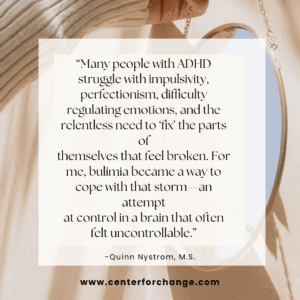Please note that this is an Archived article and may contain content that is out of date. The use of she/her/hers pronouns in some articles is not intended to be exclusionary. Eating disorders can affect people of all genders, ages, races, religions, ethnicities, sexual orientations, body shapes, and weights.
By Quinn Nystrom, MS
October is ADHD Awareness Month, and this year feels especially meaningful to me. Did you know that more than 11 million adults in the U.S. are living with ADHD? For most of my life, I never thought I’d be one of them.
I had been in and out of therapy since I was 12 years old, but it wasn’t until I was 37—while I was pregnant, no less—that a therapist finally suggested I get tested. I remember thinking: Why now? Why didn’t anyone bring this up before?
The truth is, no one suspected ADHD in me because on the outside, I looked like I had it all together. I was the “organized,” “successful” one. But if you ask my husband about the piles of random papers, laundry, and half-finished projects around our house, he’ll just chuckle and nod knowingly. The external success masked the internal chaos, and because of that, ADHD flew under the radar for decades.
 The Invisible Struggles
The Invisible Struggles
Living undiagnosed meant I internalized a lot of shame. I wondered why things felt harder for me than they seemed to for other people. Why I couldn’t focus, why I procrastinated until the last minute, why the simplest tasks sometimes felt impossible. I just assumed it was a character flaw—that I was lazy, disorganized, or not trying hard enough.
And here’s where it connects closely with another part of my story: my eating disorder. ADHD and eating disorders are deeply intertwined. Many people with ADHD struggle with impulsivity, perfectionism, difficulty regulating emotions, and the relentless need to “fix” the parts of themselves that feel broken. For me, bulimia became a way to cope with that storm—an attempt at control in a brain that often felt uncontrollable.
The Complications of Diagnosis
Getting tested while pregnant added another layer of complexity. What would treatment look like? Could I take medication safely? How would this impact me as a new mom? There were more questions than answers, but even just naming it—finally knowing that my brain worked differently—was a huge step forward.
Looking Back with Compassion
Sometimes I feel sad or even angry that it took so long for someone to connect the dots. But more often, I try to look back with compassion. I didn’t miss the signs because I wasn’t paying attention; society just hasn’t always known what ADHD looks like in women—especially women who appear “high-functioning.”
Now, I can see the whole picture. The piles around my house aren’t evidence that I’m messy or lazy; they’re part of how my brain organizes. The challenges I faced in school and work weren’t because I wasn’t trying hard enough; they were symptoms of something real. And having ADHD doesn’t cancel out my strengths—it helps explain them. My creativity, my resilience, my ability to juggle a lot at once—those are ADHD traits, too.
Why I’m Sharing This
I’m telling my story because I know I’m not alone. There are so many adults—especially women—who don’t get diagnosed until later in life. Many of us struggle in silence or try to mask our challenges so no one notices. And many of us also struggle with eating disorders, anxiety, or addiction, because we’re trying to soothe a brain that feels like it’s constantly on overdrive.
ADHD Awareness Month is about breaking down those misconceptions. It’s about seeing the whole person—not just the mask they put on.
If you’ve ever felt like something just didn’t add up, if you’ve blamed yourself for not being “better” or “more disciplined,” please know it might not be a flaw at all. It might be ADHD. And getting answers, no matter your age, can be life changing.
If any of this resonates with you, I gently encourage you to talk with a trusted therapist, doctor, or support group. You don’t have to navigate the questions—or the answers—alone.
















